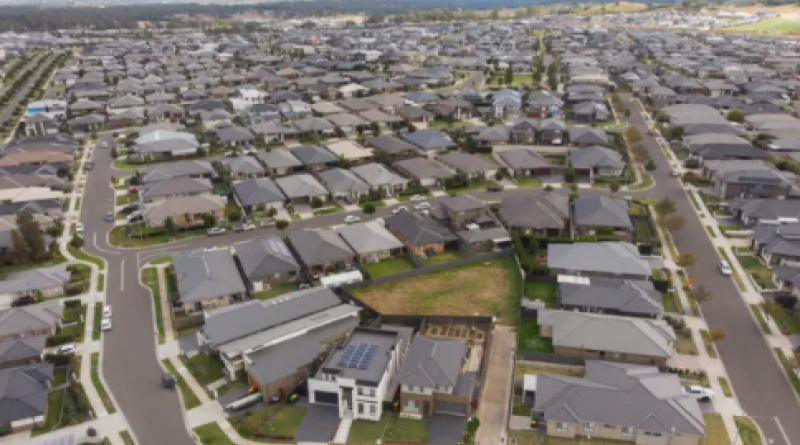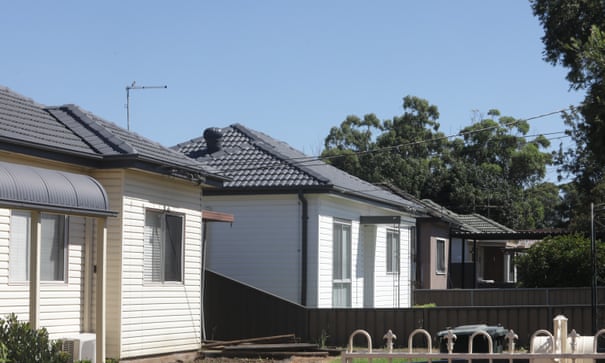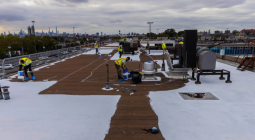Hot in the city: can a ban on dark roofs cool Sydney?

Experts who welcome the NSW proposal to deal with urban heat say it’s not about black or white but reflection and radiation.
The New South Wales government announced this week it would move to ban dark roofs as part of environmental planning rules to help the state achieve net zero emissions by 2050.
The planning minister, Rob Stokes, said on Wednesday that ditching dark roofing “would have an enormous impact on the urban heat island effect”, citing University of NSW research suggesting ambient temperatures in Sydney could drop by up to 2.4C as a result.
The announcement has been welcomed by experts.
Prof Andy Pitman, the director of the ARC Centre of Excellence for Climate Extremes at UNSW, said: “The recognition that this is a useful strategy for minimising vulnerability to climate change is terrific.”
What are the effects of roofing on housing and city temperature?
What is the urban heat island effect?
“The urban heat island effect is a phenomenon that affects a lot of big cities around the world,” says Dr Gloria Pignatta of the UNSW’s City Futures Research Centre.
The effect refers to urban centres being significantly warmer than rural areas – estimates vary between 1C and 13C on average. It occurs as a result of land modification; built-up areas have less green cover and more hard surfaces which absorb and radiate heat.

The difference in temperature between cities and rural areas is often greater at night, and previous research has suggested the density and colour of building materials are significant contributors.
Pitman says the effect doesn’t occur all year round, but depends on weather patterns.
What colour of roof is best if you want a cooler house?
In western Sydney, a light-coloured roof could reduce temperatures inside the home by 4C on average and up to 10C during a heatwave compared with darker roofing, according to research commissioned by the federal government.
Materials that are able to reflect a high portion of incoming solar energy, rather than absorbing it, make for cooler roofs. This reflectance is a property known as albedo. Generally speaking, dark-coloured surfaces have a lower albedo, absorbing more solar radiation than brighter surfaces.
“Every colour has a different behaviour in terms of reflection of light,” Pignatta says. Lighter shades within the same colour are preferable.
“It is not coincidental that a lot of Mediterranean countries have white roofs,” Pitman says.
But cooler roofing isn’t just a matter of black and white. “It doesn’t so much matter what the colour is – it matters what the reflectivity is,” Pitman says.
There are “cool” roofing materials that don’t look visibly different from traditional options but result in significantly lower temperatures as a result of specific components incorporated into their surfaces.
Pignatta cites terracotta tiles as an example. “You can have natural red clay tiles and ‘cool’ red clay tiles”, which appear to be the same hue.
“Natural red clay tiles, for example, can reach up to 60 to 70C on a clear sunny day,” she says. The second option results in a temperature 10C or more cooler.

“They don’t work in the visible spectrum … but they are able to reflect solar radiation in the infrared spectrum.”
Cooler options exist for surfaces of most colours, Pignatta says, adding it is also useful for asphalt on roads, given the visual impracticality of driving on reflective white streets.
Whether an area is built up is also a factor to consider. “If you have a mix of high-rise buildings and low-rise buildings and you have cool roofs on the low rises, you can create an impact on the buildings that are close to them because of the solar reflection,” Pignatta says.
Does roofing material matter?
When it comes to cooling, it’s not only how well the material reflects sunlight that matters, but also how well it radiates heat – a property known as thermal emissivity.
“In summer, what you’re looking for is a surface that doesn’t absorb sunlight but radiates heat really well,” Pitman says.
Metals have a low thermal emissivity, and hence do not readily release any heat they have absorbed. “They are not good materials to be used in the urban environment, especially if you consider large surfaces … even if they are white,” Pignatta says.
Other materials such as clay tile, gravel or membrane roofing are preferable because they all have “generally quite high thermal emissivity”, she says.
Green roofs are also an option to consider if light-coloured vegetation is chosen, as such plants have a higher albedo, Pignatta says.
They can have an evaporative cooling effect if well watered, Pitman says. “Green roofs need to be sufficiently moist to cool themselves,” he says, warning this can be difficult to achieve during drought and extreme heat events.
What effects do cool roofs have in winter?
In the winter, solar energy absorbed by a roof can add warmth to a building. In some locations, houses with cool roofs may require more energy for heating – an effect known as the winter heating penalty.
“In western Sydney, the balance has got to be [that] you don’t want to absorb the heat,” Pitman says. “But that’s not the case everywhere.”
The effect is also complicated by how well a building is insulated. “Australian buildings are amongst the worst in the world,” Pitman says. “We are absolutely, unambiguously crap at building houses for optimal energy efficiency.”
There are potential solutions in development, Pignatta says, such as thermochromic materials – those that change colour depending on temperature. “So in winter they become more dark, and they absorb more heat, and during summer they become more light.”
What about black solar panels?
Even though they are dark, one of the advantages of solar panels is that they are designed to convert solar energy into electricity, Pitman says. “The roof isn’t heating up, it’s using the energy to create electricity.”
Excessively high temperatures can reduce the efficiency of solar panels, Pignatta says, and may be more efficient when installed on light roofs or those made of reflective materials.
20 Nοεμβρίου 2021
The Guardian




